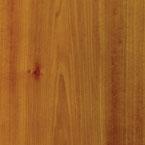Sponsored by: Weyerhaeuser Hardwoods
Popular Product
| Family Name: Liriodendron tulipfera of the Family Magnoliaceae Common Names: Yellow poplar, poplar, hickory poplar, tulip poplar, tulipwood, tulip tree, canary wood, canary whitewood, American whitewood, saddletree, popple. Height/Weight: Yellow poplar is considered a large tree. Its average height is 150 to 160 feet, with the tallest tree on record reaching a height of 190 feet. The average weight is 31 pounds per cubic foot, with a specific gravity of 0.51. Properties: Yellow poplar kiln dries well and easily and will air dry with little degrade. It has small movement in service. The wood is generally non-durable, low bending and glues very well. Other wood properties include: straight grain, medium to fine texture, resistance to shock loads, low stiffness, medium crushing strength with medium steam-bending classification, and small tendency to split when nailed. |
Yellow poplar is one of those woods with a wide range of names, among them canarywood, canoewood, tulipwood and tulip poplar. It is not a true poplar, however, but from the species Liriodendron tulipfera, related to the magnolia tree.
Yellow poplar, also known as American whitewood, should not be confused with the softwood whitewood species Picea abies and Picea alba. Yellow poplar makes up about 9 percent of the hardwood forest and is widespread throughout the eastern and southern United States. It is readily available in a variety of thicknesses, but 4/4 is the primary thickness.
Dave Bosley, Weyerhaeuser Hardwoods product manager, said yellow poplar can be used in a variety of applications, including exposed and hidden furniture parts, mouldings and millwork, cabinetry, picture frames, turnings and joinery.
“Yellow poplar is shipped to export markets in large volumes due to its relatively low cost, steady availability and proximity to ports on the East Coast of the USA,” said Bosley. “Asian customers use yellow poplar in much of the same applications that they would use hemlock, rubberwood and other such ‘price point’ woods. It is used extensively for furniture as long as the finish is a medium to dark stain. European accounts use it for moulding, millwork and doors. China, Vietnam, Mexico and Italy are large buyers of yellow poplar.”
Other uses for the wood include light construction, doors, paneling, edge-glued panels and plywood. It also is used for pattern making, interior trim for boats, doors and toys. Some logs are sliced into veneer.
Yellow poplar is a medium density wood. It accepts paint very well, although occasionally, woodworkers will use a natural finish to highlight the color variation of the wood, which can range from off-white to yellow to tan, green and purple.
Paul Oppold, marketing manager for Young Furniture in Bow, NH, said his company uses paint-grade yellow poplar in its unfinished cabinets. “Yellow poplar is one of several species we offer of unfinished solid wood cabinetry. It machines well and staples well. It does have great color variability so we offer it in a paint grade versus stained. It is [readily] available and offers tremendous yields,” he said. Unfinished yellow poplar cabinetry accounts for about 30 percent of Young’s sales annually, he said.
| |
| Painted yellow poplar. Photo courtesy of Young Furniture. |
Usage Study Details Growth, Popularity
Daniel Cassens, Professor of Wood Products/Extension Specialist at Purdue University, has co-authored a study on yellow poplar and its usage. “Until the early part of the 20th century, yellow poplar was used extensively throughout its range for exterior and interior applications. As yellow poplar was depleted in these areas, the timber industry moved west and south for new sources of lumber.”
Now, Cassens said, indications are that “the yellow poplar resource has recovered and plentiful supplies of relatively inexpensive lumber are available. And because yellow poplar was once an excellent species for exterior millwork, many individuals are again using it in those applications.”
It is an abundant, fast drying and easily worked hardwood species, Cassens added. “In terms of availability and properties, yellow poplar is a very viable resource when compared to the traditional western softwoods, including Ponderosa and Jeffrey pines.”
Additional work is being conducted to better understand what natural decay resistance the heartwood of today’s yellow poplar timber might have for exterior applications. They are also looking at thermal treating or toasting as a means of improving decay resistance. Toasting was developed in Europe as traditional wood preservatives were eliminated from the market, Cassens said. Thermal treatment helps to stabilize the wood, but at high temperatures the wood can also experience a loss of mechanical properties.






Have something to say? Share your thoughts with us in the comments below.